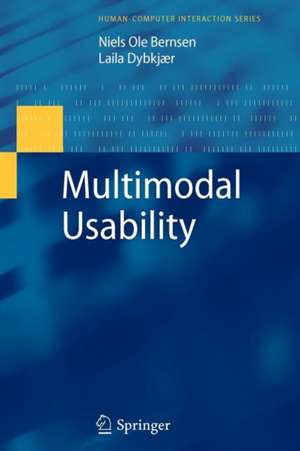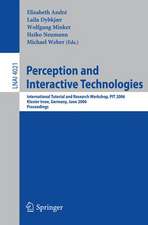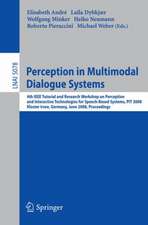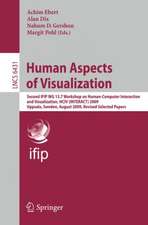Multimodal Usability: Human–Computer Interaction Series
Autor Niels Ole Bernsen, Laila Dybkjæren Limba Engleză Paperback – 14 mar 2012
| Toate formatele și edițiile | Preț | Express |
|---|---|---|
| Paperback (1) | 994.40 lei 6-8 săpt. | |
| SPRINGER LONDON – 14 mar 2012 | 994.40 lei 6-8 săpt. | |
| Hardback (1) | 1000.84 lei 6-8 săpt. | |
| SPRINGER LONDON – 19 oct 2009 | 1000.84 lei 6-8 săpt. |
Din seria Human–Computer Interaction Series
- 20%
 Preț: 655.85 lei
Preț: 655.85 lei - 20%
 Preț: 309.25 lei
Preț: 309.25 lei - 20%
 Preț: 375.54 lei
Preț: 375.54 lei - 20%
 Preț: 644.48 lei
Preț: 644.48 lei - 20%
 Preț: 667.75 lei
Preț: 667.75 lei - 20%
 Preț: 664.44 lei
Preț: 664.44 lei - 20%
 Preț: 1164.84 lei
Preț: 1164.84 lei - 20%
 Preț: 817.55 lei
Preț: 817.55 lei - 20%
 Preț: 657.16 lei
Preț: 657.16 lei - 20%
 Preț: 645.31 lei
Preț: 645.31 lei - 20%
 Preț: 938.66 lei
Preț: 938.66 lei - 15%
 Preț: 658.05 lei
Preț: 658.05 lei - 20%
 Preț: 822.51 lei
Preț: 822.51 lei - 20%
 Preț: 654.21 lei
Preț: 654.21 lei - 20%
 Preț: 994.26 lei
Preț: 994.26 lei - 20%
 Preț: 1621.89 lei
Preț: 1621.89 lei - 20%
 Preț: 991.60 lei
Preț: 991.60 lei - 20%
 Preț: 783.45 lei
Preț: 783.45 lei - 20%
 Preț: 1175.42 lei
Preț: 1175.42 lei - 20%
 Preț: 659.97 lei
Preț: 659.97 lei - 20%
 Preț: 219.15 lei
Preț: 219.15 lei - 20%
 Preț: 334.86 lei
Preț: 334.86 lei - 20%
 Preț: 969.84 lei
Preț: 969.84 lei - 20%
 Preț: 642.19 lei
Preț: 642.19 lei - 20%
 Preț: 314.39 lei
Preț: 314.39 lei - 20%
 Preț: 661.14 lei
Preț: 661.14 lei - 20%
 Preț: 995.89 lei
Preț: 995.89 lei - 20%
 Preț: 752.58 lei
Preț: 752.58 lei - 20%
 Preț: 990.30 lei
Preț: 990.30 lei - 20%
 Preț: 990.12 lei
Preț: 990.12 lei - 20%
 Preț: 336.21 lei
Preț: 336.21 lei - 20%
 Preț: 334.71 lei
Preț: 334.71 lei - 20%
 Preț: 312.62 lei
Preț: 312.62 lei - 20%
 Preț: 994.92 lei
Preț: 994.92 lei - 20%
 Preț: 331.74 lei
Preț: 331.74 lei - 20%
 Preț: 646.80 lei
Preț: 646.80 lei - 20%
 Preț: 334.86 lei
Preț: 334.86 lei - 20%
 Preț: 329.76 lei
Preț: 329.76 lei - 20%
 Preț: 332.24 lei
Preț: 332.24 lei - 20%
 Preț: 992.11 lei
Preț: 992.11 lei - 20%
 Preț: 650.40 lei
Preț: 650.40 lei - 20%
 Preț: 337.00 lei
Preț: 337.00 lei - 20%
 Preț: 332.39 lei
Preț: 332.39 lei - 20%
 Preț: 1279.86 lei
Preț: 1279.86 lei - 15%
 Preț: 636.12 lei
Preț: 636.12 lei - 20%
 Preț: 336.67 lei
Preț: 336.67 lei - 20%
 Preț: 1000.70 lei
Preț: 1000.70 lei - 20%
 Preț: 645.14 lei
Preț: 645.14 lei
Preț: 994.40 lei
Preț vechi: 1243.00 lei
-20% Nou
Puncte Express: 1492
Preț estimativ în valută:
190.27€ • 199.20$ • 157.44£
190.27€ • 199.20$ • 157.44£
Carte tipărită la comandă
Livrare economică 05-19 aprilie
Preluare comenzi: 021 569.72.76
Specificații
ISBN-13: 9781447125174
ISBN-10: 1447125177
Pagini: 448
Ilustrații: XVI, 431 p. 88 illus.
Dimensiuni: 155 x 235 x 24 mm
Greutate: 0.62 kg
Ediția:2010
Editura: SPRINGER LONDON
Colecția Springer
Seria Human–Computer Interaction Series
Locul publicării:London, United Kingdom
ISBN-10: 1447125177
Pagini: 448
Ilustrații: XVI, 431 p. 88 illus.
Dimensiuni: 155 x 235 x 24 mm
Greutate: 0.62 kg
Ediția:2010
Editura: SPRINGER LONDON
Colecția Springer
Seria Human–Computer Interaction Series
Locul publicării:London, United Kingdom
Public țintă
Professional/practitionerCuprins
Structure, Usability, Readership.- Intermezzo 1: Three Multimodal Cases.- Creating a Model of Use.- Modalities and Devices.- Intermezzo 2: Status on Cases and Next Steps.- Common Approaches, Methods, Planning.- Intermezzo 3: Case Usability Workplan, Design.- Question-Answering.- Meetings with Discussion.- Observation of Users.- Imagination.- Interaction with the System.- Lab Sessions with Subjects.- Intermezzo 4: Case Usability Method Plan.- Data Handling.- Usability Data Analysis and Evaluation.- Intermezzo 5: Sudoku Usability Evaluation.- Multimodal Usability: Conclusions and Future Work.
Textul de pe ultima copertă
Multimodal Usability demonstrates several major generalisations of human-computer interaction and extends the traditional focus on graphical user interfaces to all input/output modalities accessible to vision, hearing, and touch.
Multimodal Usability can help make a multimodal interactive system usable no matter if you are building a work tool or a game, and whether your system models aspects of people, like a virtual (or robot) companion or friend, or not.
Successful implementation can be achieved using the following usability development steps:
(1) Augment system model specification with an AMITUDE model of use specified in terms of Application type, Modalities, Interaction type, Task, User, Device and Environment of use.
(2) Apply usability methods to collect the usability data needed at any time. A toolbox of 24 key methods are presented in a common format. Methods are of five kinds: question-answering, meetings with discussion, observation, imagination, and interaction with the system.
(3) For each method application, post-process, annotate, analyse, report, and act on the data to improve system model usability.
Three multimodal system Cases are included to illustrate usability development from idea to user test of the implemented prototype.
Multimodal Usability assumes no prior knowledge about usability and human-computer interaction.
Multimodal Usability can help make a multimodal interactive system usable no matter if you are building a work tool or a game, and whether your system models aspects of people, like a virtual (or robot) companion or friend, or not.
Successful implementation can be achieved using the following usability development steps:
(1) Augment system model specification with an AMITUDE model of use specified in terms of Application type, Modalities, Interaction type, Task, User, Device and Environment of use.
(2) Apply usability methods to collect the usability data needed at any time. A toolbox of 24 key methods are presented in a common format. Methods are of five kinds: question-answering, meetings with discussion, observation, imagination, and interaction with the system.
(3) For each method application, post-process, annotate, analyse, report, and act on the data to improve system model usability.
Three multimodal system Cases are included to illustrate usability development from idea to user test of the implemented prototype.
Multimodal Usability assumes no prior knowledge about usability and human-computer interaction.
Caracteristici
First to address interactive systems development and evaluation for usability from a thoroughly multimodal perspective First to argue that the field of human-computer interaction needs complete re-orientation to take into account the fact that GUI-based systems merely represent a single modality combination among thousands of others Presents a thorough introduction to modalities and multimodality The authors have a 16 year track record of usability-oriented research and development of novel, non-GUI-based systems, multimodal natural interactive systems, and modality theory




























